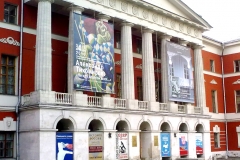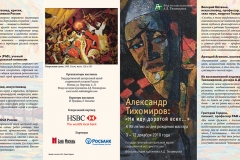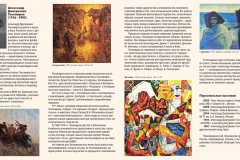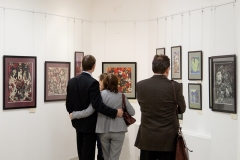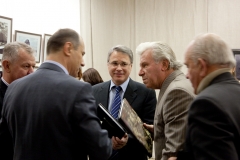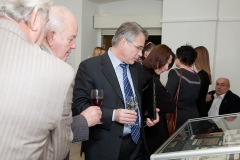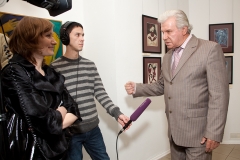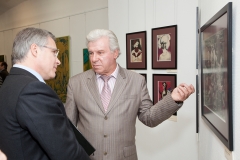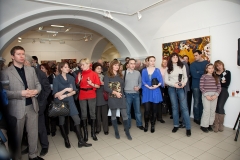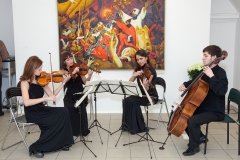Formal opening of retrospective exhibition “Alexander Tikhomirov: I’m not walking the path of the many…”, devoted to 95th anniversary of the birth of the master, took place in the halls of the State Central Museum of Contemporary History of Russia in the evening of December, 2, 2010. Exposition consisted of 55 pictorial and graphic works from collection of Heritage Foundation of the Artist and private collections. For the first time viewing audience could see many of his works which have never been exhibited before, created in different periods of time and, most importantly – his earlier works: portraits and realistic genre-scenes (1920-1950-s), impressionist landscapes and graphics of the 1950-s, allowing to gain full insight on formation and development of A.D. Tikhomirov as an artist, as well as to get an idea about the way he travelled in art – starting from realism and up to neoclassic. For the first time exhibition included sketches and materials from the artist’s archive related to his work at the Memorial and Decorative Art Concern and creation of Leniniana. Exhibition also contained photos from the family album, personal belongings of A.D. Tikhomirov, and catalogues of exhibitions with autographs of other artists who were friends with the master – S.Ya. Adlivankin, A.M. Gluskin, E.D. Simkin, I.M. Ilyin.
Exhibition coincided with release of the catalogue “A.D. Tikhomirov. Art. Graphics”, containing more than 130 works of the artist. Opening of the exhibition was covered by “Culture” and RUSSIA TODAY TV channels, as well as by “Kommersant FM” radio station.
AT THE OPENING
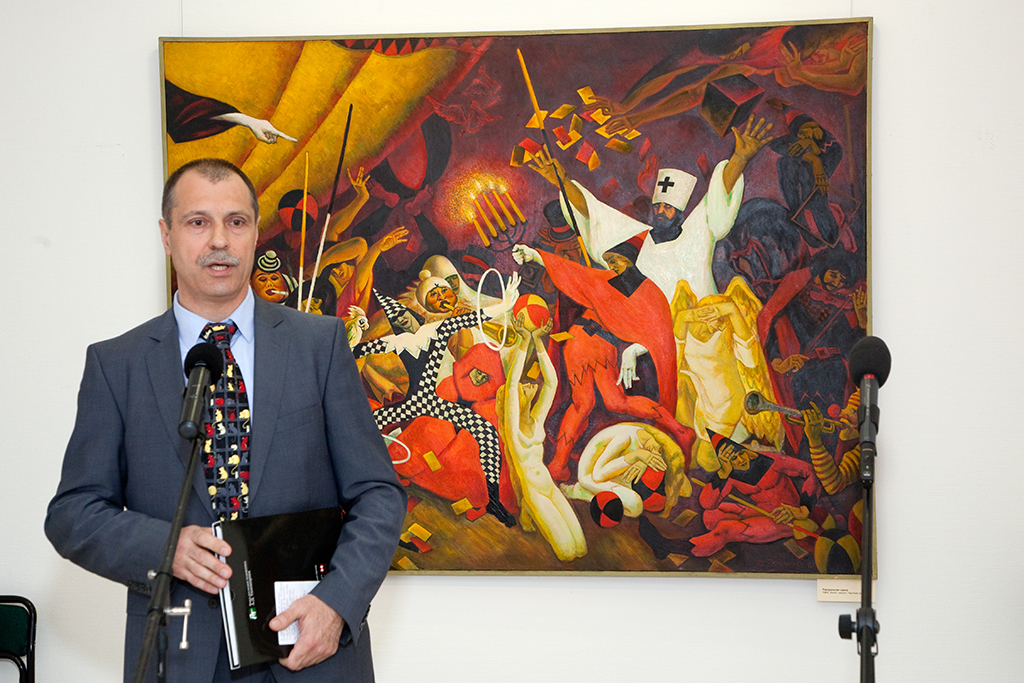
Quote from the speech of Gennady Anatolyevich Zhigarev, Chairperson of Supervisory Council of Heritage Foundation of the Artist A.D. Tikhomirov:
Good evening, ladies and gentlemen!
We are glad to welcome you at the exhibition of works of Alexander Dmitrievich Tikhomirov, who would have been 95 on the 1st of January 2011.
I would like to express gratitude to the management of Museum of Contemporary History of Russia for giving us an opportunity to organize this exhibition in halls of the museum, tribute also goes to our general partner – HSBC Bank and the Russian banks, our partners – Rosbank and the Bank of Moscow. And first of all, I would like to give the floor to Uritskaya Irina Feliksovna, exhibition supervisor.

Quote from the speech of Irina Feliksovna Uritskaya, Exhibition Supervisor:
Good evening, dear friends!
Thank you for attending this festival of art, festival of pictorial art. Today we are glad to introduce an artist, little known for many of you, as he didn’t have many exhibitions and his works have practically not been published. His colleagues knew him as an artist working on paintings devoted to Lenin, whose portraits have been displayed on high-risers of Moscow, including the building of the Ministry of Foreign Affairs. And it was these works the artist has been known for. But today I have a pleasure of introducing you his inexhaustible heritage. And all of these works tell us how multifaceted this artist has been, how deep his philosophy was and how seriously he treated every theme which seemed to be important for him in life. These are themes of music, presented in his pictures devoted to music, themes of theatre and circus, and the theme of deep personal love. Thank you very much again for coming.
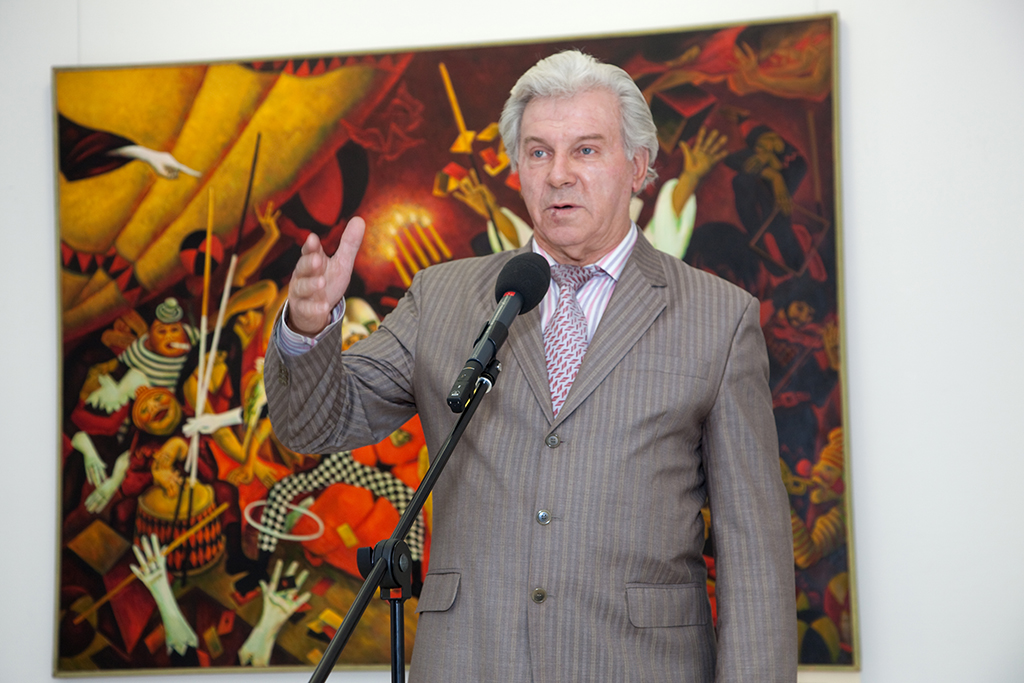
Quote from the speech of Valery Alexandrovich Matveev, friend of the artist, art expert, Doctor of Engineering Science, professor of the Moscow State Technical University named after N.E. Bauman:
Ladies and gentlemen, I’m happy to welcome all of you here. I remember Alexander Dmitrievich saying: “When I die, my works will be exhibited in central halls of the museums and chased by the completists”. Indeed, now the time is coming for his words to come true.
He had a studio on Baltiyskaya. And across the street there’s been an office of the Central Construction Bureau “Almaz”, working in the field of ballistic missile defense, and I have been working in this company and used to visit him even during the lunch breaks to speak about various problems. I was surprised: Alexander Dmitrievich was a top level maestro, a person of the broadest range, possessing tremendous knowledge of art. He had an old record player in his studio and would always listen to the music while working.
When I came to his studio for the first time, he asked me: “Who is your favorite painter?”. I replied: “Vrubel”, and he said: “Oh, we’ll be friends with you”. And indeed, our friendship lasted over a very long time.
And I’m happy to see professor Arkharov Alexey Mikhailovich representing Bauman Moscow State Technical University here. We both have been closely related to Bauman college. Engineers and scientists have always been very perceptive to his art. It’s very creative, passionate, calling towards some heights, and we’ve always felt that. And I remember that when we were buying out the paintings from Alexander Dmitrievich, and would always give a good price for them, he used to say: “You are saving my works”.
Once I visited him together with the art expert Moskvinov, and when he saw the paintings, he said: “Oh my God, this is a Soviet Michelangelo!” And it resided in our memory that he is a Soviet Michelangelo.
I’d like to say, that Gennady Anatolyevich, the graduate of Bauman Moscow State Technical University, managed to support and, I’d say, keeps fostering Tikhomirov’s endeavors. This is very important: an artist gains value when supported by broad audience, and especially when there is a leader. That’s why I’m very grateful, first of all, to the artist’s heirs for devoting themselves to his memory – this is terrific. And it’s important to have a person supporting this – Gennady Anatolyevich Zhigarev.
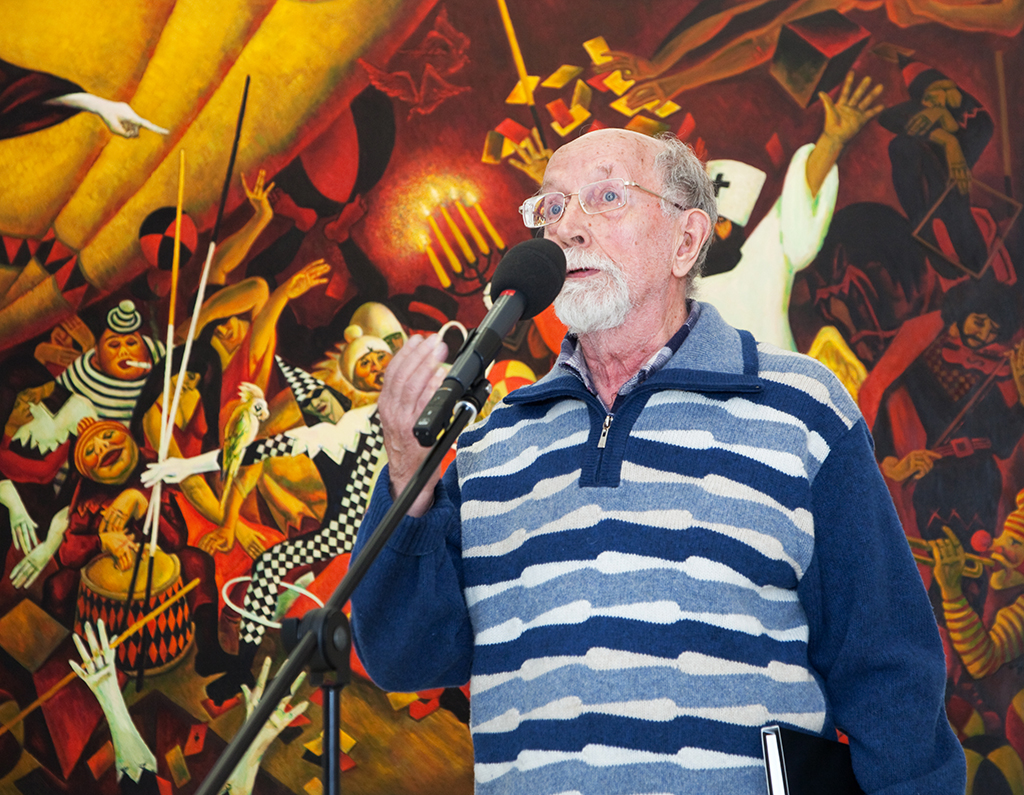
Quote from the speech of Lev Fyodorovich Dyakonitsyn, artist and art expert:
When I saw the paintings of Alexander Dmitrievich for the first time, I was stricken by courage and originality of his works, the feeling of opening a completely new page in the history of Soviet art. I think of him as of the great artist, as it’s his search which makes him great – first of all, search of composition, color, and secondly, search of a human nature.
He demonstrates superfine exploration of a person’s inner space, and subconscious is basic for anyone, and plays a key role in life orientation. That’s why the words of Stanislavsky come to my mind, who used to say: “I believe it” or “I do not believe it”. Looking at the paintings of Alexander Dmitrievich, you believe them, as he showed different sides of human behavior, managed to find place of a person in space, and convey the feeling of being squeezed, questions coming from many of his characters along with the feeling of rejoicing organized by people for each other.
I think that nowadays his works retained their pertinence and importance for development of art. Indeed, if you take a look at the recent exhibitions you will notice that the painting no longer exists, it has disappeared, being replaced by some kind of sketches, drafts, – very smooth but missing serious program, which is a distinguishing feature of a painting.
Here we can see that any painting – is a deep exploration of a person’s psychological status, and his condition when placed within a framework of a theatre. Theatre is a mirror of our life, that’s why it is in the theatre and especially in the circus where a person tries his strength of a character, his firmness, giving definite, very deep program for creativity. If you remember, early Picasso started his career with these very themes – theme of an abject person, at the same time bringing joy to other people, a person overcoming his own unhappiness. And Alexander Dmitrievich’s characters are so different-sized and beautiful that, I would say, up to now, they could be used as models for contemporary art. This is a very important feature.
I would like to thank organizers of this exhibition, who displayed these works, starting from early art and up to the later creative period. On one hand, his works contain bright source of life, on the other – they are a bit pessimistic, dramatic, exploring people standing aside from the society and vices, for example, or insanity and submergence of characters into some kind of illusionary world, the world of buffoonery, the world of stupefy. But people are stuck there involuntarily, that’s why we feel sorry for them wishing to the characters to discover themselves in another way. And such sympathy caused by the artist in us – is a great discovery of unconscious. I think that now it’s up to the scientists to discover new possibilities of our behavior, and not only of the conscious one, but also of a sensual and lively like the flow of life itself.
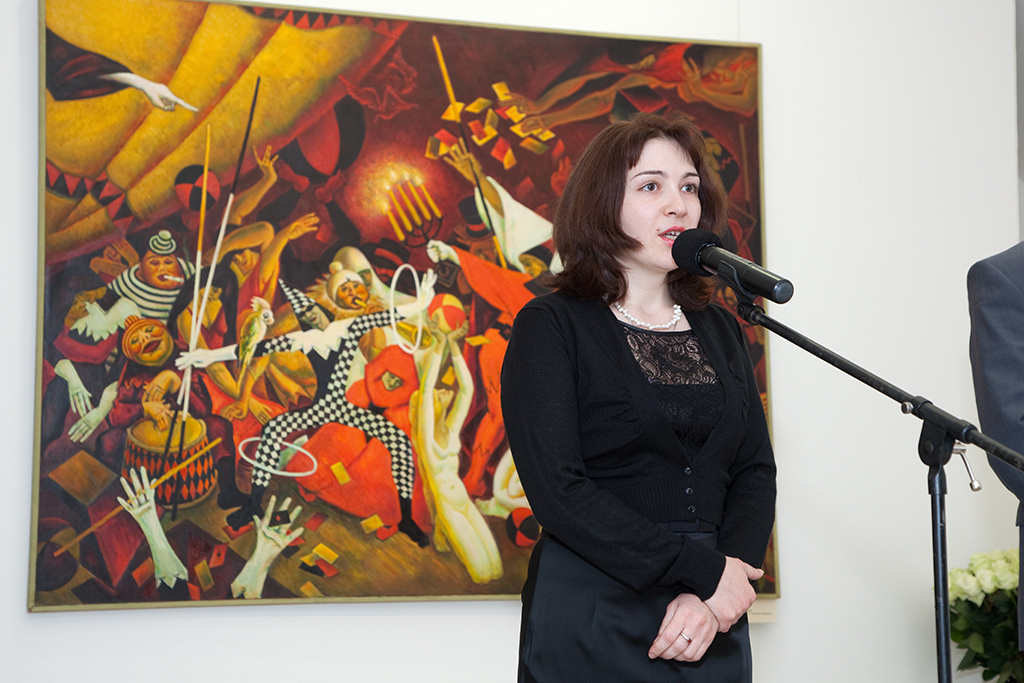
Quote from the speech of Ekaterina Nikolaevna Gogoleva, biographer and expert of A.D. Tikhomirov’s art, exhibition supervisor:
Good evening, ladies and gentlemen!
We are glad to welcome you at the exhibition of works of Alexander Dmitrievich, a painter from the range of artists who are not so widely known as they should be.
He lived and worked during the Soviet times, and left his mark into the history of the Soviet official art of the 50-70-s as an author of Leniniana and the creator of Lenin’s world largest portrait. But his lifework belonged to the paintings which have been over decades shown almost to no one, except for a small circle of his colleagues, art experts, completists and musicians.
Alexander Dmitrievich paid special attention to spiritual world of a person, search of own place in life, true “self”, he often appealed to biblical scenes in his art works. Exiles, vagabonds, outcasts, – all those who did not wish to live by the laws of double-faced and ignorant crowd, – became the main characters of his paintings.
We may say that Alexander Dmitrievich lived two lives: life in official art and another one – secret, tragic and sincere. For he faced many difficulties, starting from partial loss of eye-sight in his early days and down to non-recognition of his works for many years later on. However, he never lost his courage and never stopped pursuing his goal – to find his own way in art.
He was from among the artists undertaking independent search of their way in art, and never joined any groups or movements in unofficial art of the 50-70-s.
He painted portraits of Lenin and the party leaders, and these portraits were so great in size that they had to be painted on the field of “Dinamo” stadium, as only there it was possible to place the entire picture on one piece of land. It was there where he created the world’s largest portrait of Lenin. There is an interesting story linked to this portrait, placed on the frontage of the building of the Ministry of Foreign Affairs.
In 1975, during the public holidays, a distinguished guest – famous Italian communist artist Renato Guttuso – passed by the building of the Ministry of Foreign Affairs in the car. He saw the portrait made by Tikhomirov and expressed his excitement over the size of the painting and high quality of performance to the member of Politbureau, First Secretary of the Moscow City Committee of the Party Grishin, accompanying him. The latter was not aware of the name of the author, however, praise of distinguished guest made him find it out, and soon Tikhomirov has been awarded with golden medal of the Visual Propaganda Exhibition which took place in the Exhibition of Economic Achievements, and also granted with keys from the studio to which he had not been entitled earlier, not being a member of the Moscow branch of the Union of Artists. And the reason for him not be a member is as follows: when he studied at Sourikov Institute under Alexander Osmyorkin, who was a follower of traditions of the Western artists, first and foremost of Cézanne, Tikhomirov became fond of impressionism and post-impressionism. He started trying himself in new styles and has been dismissed from the institute for demonstrating formalistic trends in art.
But before that, when he didn’t have an opportunity to work in his own studio, he worked in the room in communal flat, and over the summer months moved to Troitskoye village where he rented a house with his family. It was during the 60-s, when Troitskoye has been a favorite place of artistic community, where the artists following the traditions of 20-s would come to rest and work – Adlivankin, Labas, Talberg, Gluskin. Everyone was working during the day, and in the evening they would gather at Tikhomirovs’ to discuss what they’ve been doing that day, and speak about the art.
And now, already by the middle of 70-s, Alexander Dmitrievich could continue artistic experiments in his own studio and create paintings not only on biblical scenes, but also on the themes of theatre and circus, inspired by his memories of Baku, where he had a part-time job at the circus drawing posters, as well as Shakespeare’s dramas and Fellini’s movies.
He left us an unique artistic heritage and was an artist, who worked in his studio every day. He used to go there every day, like a worker goes to the factory, worked for 8 hours, and continued doing it till the very last days of his life.
And today you see part of his works in these halls. Wishing you a pleasant viewing. Watch. Feel.
Thank you.
Concluding the opening ceremony, musicians of the string quartet “RUSQUARTET” consisting of Anna Snezhina (first violin), Anna Yanchishina (second violin), Mariya Teplyakova (alto) and Alexandra Dulova (cello) played the following compositions: Wolfgang Amadeus Mozart “Quartette in D major k 283”, P.I. Chaikovsky “Quartette number 3” and Andante cantabile from quartette number 1, A.P. Borodin “Nocturne from quartette number 2», Joseph Haydn “Quartette Op. 76 number 3”.
Ekaterina Gogoleva, Exhibition Supervisor

